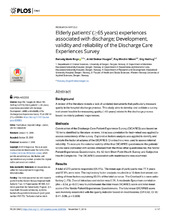| dc.contributor.author | Boge, Ranveig Marie | en_US |
| dc.contributor.author | Haugen, Arvid Steinar | en_US |
| dc.contributor.author | Nilsen, Roy Miodini | en_US |
| dc.contributor.author | Harthug, Stig | en_US |
| dc.date.accessioned | 2019-03-29T15:56:48Z | |
| dc.date.available | 2019-03-29T15:56:48Z | |
| dc.date.issued | 2018-11-07 | |
| dc.Published | Boge RM, Haugen AS, Nilsen RM, Harthug S. Elderly patients’ (≥65 years) experiences associated with discharge; Development, validity and reliability of the Discharge Care Experiences Survey. PLoS ONE. 2018;13(11): e0206904. | eng |
| dc.identifier.issn | 1932-6203 | |
| dc.identifier.uri | https://hdl.handle.net/1956/19259 | |
| dc.description.abstract | Background: A review of the literature reveals a lack of validated instruments that particularly measure quality in the hospital discharge process. This study aims to develop and validate a survey instrument feasible for measuring quality (≥65 years) related to the discharge process based on elderly patients’ experiences. Methods: Construction of the Discharge Care Patient Experience Survey (DICARES) was based on 16 items identified by literature reviews. Intraclass correlation for test–retest was applied to assess consistency of the survey. Explorative factors analysis was applied to identify and validate the factor structures of the DICARES. Cronbach’s α was used to assess internal reliability. To evaluate the external validity of the final DICARES questionnaire the patients’ scores were correlated with scores obtained from the three other questionnaires; the Nordic Patient Experiences Questionnaire, the 12-Item Short-Form Health Survey and Subjective Health Complaints. The DICARES association with readmissions was examined. Results: A total of 270 patients responded (64.4%). The mean age of participants was 77.1 years and 57.8% were men. The exploratory factor analysis resulted in a 10-item instrument consisting of three factors explaining 63.5% of the total variance. The Cronbach’s α were satisfactory (≥70). Overall intraclass correlation was 0.76. A moderate Spearman correlation (rho = 0.54, p <0.01) was found between the total mean DICARES score and total mean score of the Nordic Patient Experiences Questionnaire. The total mean DICARES score was inversely associated with the quality indicator based on readmissions (OR 0.62, CI 95: 0.41–0.95, p = 0.028) Conclusion: We have developed a 10-item questionnaire consisting of three factors which may be a feasible instrument for measuring quality of the discharge process in elderly patients. Further testing in a wider population should be carried out before implementation in health care settings. | en_US |
| dc.language.iso | eng | eng |
| dc.publisher | Public Library of Science | eng |
| dc.relation.uri | https://journals.plos.org/plosone/article?id=10.1371/journal.pone.0206904 | |
| dc.rights | Attribution CC BY | eng |
| dc.rights.uri | http://creativecommons.org/licenses/by/4.0/ | eng |
| dc.title | Elderly patients’ (≥65 years) experiences associated with discharge; Development, validity and reliability of the Discharge Care Experiences Survey | en_US |
| dc.type | Peer reviewed | |
| dc.type | Journal article | |
| dc.date.updated | 2018-11-15T09:41:31Z | |
| dc.description.version | publishedVersion | en_US |
| dc.rights.holder | Copyright 2018 The Authors | |
| dc.identifier.doi | https://doi.org/10.1371/journal.pone.0206904 | |
| dc.identifier.cristin | 1630504 | |
| dc.source.journal | PLoS ONE | |
| dc.relation.project | Helse Vest RHF: 911936 | |
| dc.relation.project | Helse Vest RHF: HV1172 | |

